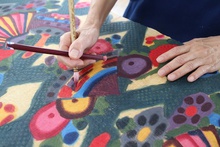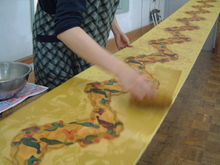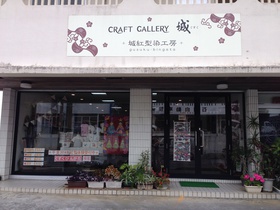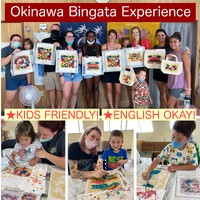 › GusukuBingataDyeingStudio Okinawan gift&BingataDyeingEeperience【Blog】 › ★Production scene › Process of Bingata Dyeing【Okinawan Traditional Craft】
› GusukuBingataDyeingStudio Okinawan gift&BingataDyeingEeperience【Blog】 › ★Production scene › Process of Bingata Dyeing【Okinawan Traditional Craft】2016年10月20日
Process of Bingata Dyeing【Okinawan Traditional Craft】
Ryukyu Bingata” is a traditional dyeing method in Okinawa since about 500 years ago.
That was born in Okinawa through absorbing the influx of cultures from mainland Japan and
China/Southeast Asian countries and assimilating the nature of the island.
It is said that the word, Bingata, originates from combining two words;
“Bin” which means colors, and “Gata” which means forms.
【Process of Bingata Dyeing】
The Bingata dyeing can be categorized into
two major methods that are “Katazome” and Tsutsugaki”.
Main Procedure of Katazome!
1.Cutting out the base design
Cutting the design out using a small knife
2.Placing the form
Placing the design form on a fabric, and using a spatula to
spread the masking starch on the entire fabric.
Masking starch is a paste made by combining steamed
glutinous rice mixed with rice bran.
3.Coloring (Arrange color scheme)
Distributing light colors first.
Soymilk is mixed in the paint since the paint is insoluble and would not set into fabric.
The protein in soymilk makes the paint to set into the fabric.

4.Coloring (Second coat)&Shading
Adding darker colors to blur in order to make the design look three-dimensional.
This technique is unique to Bingata.

5.Painting the background
Painting the background with paint or ink.
Natural inks such as indigo or Fukugi are commonly used.
6.Rinsing (Soaking)
Soaking in the water to soften and wash off the masking starch and extra paint.
Change water often and make sure the colors do not get blur.
Complete with the final step such as steaming.
7.Finish
Dry!Completion.
[Adding new taste while preserving the traditions!]
Experienced craftsmen are wholeheartedly dyeing each fabric at the factory located in Okinawa,Japan.
*Reservation needs to be made 3day in advance.*
【How to make a reservation】
reservation request form easily.
 Make a resaervation
Make a resaervation
■Our Shop information&Access↓
http://gusukubingata1971.ti-da.net/e7990797.html
The dye factory and a gift shop are at the same location.
An array of uniquely hand-dyed household and interior items
are available at our shop.
All which are designed by professional Bingata craft-women.


***************************************************
Gusuku Bingata Dyeing Studio(城紅型染工房)
【Shop&Studio】〒901-2102 Maeda4-9-1,Urasoe-city,Okinawa,Japan.
【Mapcode】33 223 817
【OPEN 】10:00~18:00(Closed on Sunday)
【T E L】098-887-3414
【E-MAIL】gusuku_b@yahoo.co.jp
【Facebook/English】 https://www.facebook.com/gusukubingata.okinawa
【Facebook/Traditional Chinese】 https://www.facebook.com/gusukubingata.okinawa.tw/
【Instagram】 https://instagram.com/gusukubingata_okinawa/
【Twitter】 https://twitter.com/gusukubingata
【Internet-order service】 http://www.gusukubingata.com
(delivered Only in Japan)
***************************************************
【How to make a reservation】
reservation request form easily.
 Make a resaervation
Make a resaervation■Our Shop information&Access↓
http://gusukubingata1971.ti-da.net/e7990797.html
The dye factory and a gift shop are at the same location.
An array of uniquely hand-dyed household and interior items
are available at our shop.
All which are designed by professional Bingata craft-women.

***************************************************
Gusuku Bingata Dyeing Studio(城紅型染工房)
【Shop&Studio】〒901-2102 Maeda4-9-1,Urasoe-city,Okinawa,Japan.
【Mapcode】33 223 817
【OPEN 】10:00~18:00(Closed on Sunday)
【T E L】098-887-3414
【E-MAIL】gusuku_b@yahoo.co.jp
【Facebook/English】 https://www.facebook.com/gusukubingata.okinawa
【Facebook/Traditional Chinese】 https://www.facebook.com/gusukubingata.okinawa.tw/
【Instagram】 https://instagram.com/gusukubingata_okinawa/
【Twitter】 https://twitter.com/gusukubingata
【Internet-order service】 http://www.gusukubingata.com
(delivered Only in Japan)
***************************************************
Posted by GUSUKU_OKINAWA at 20:52│Comments(0)
│★Production scene






